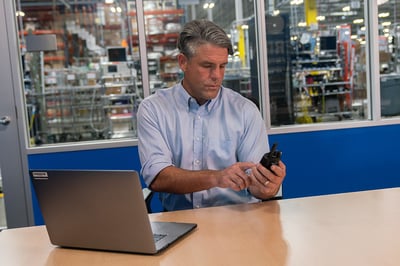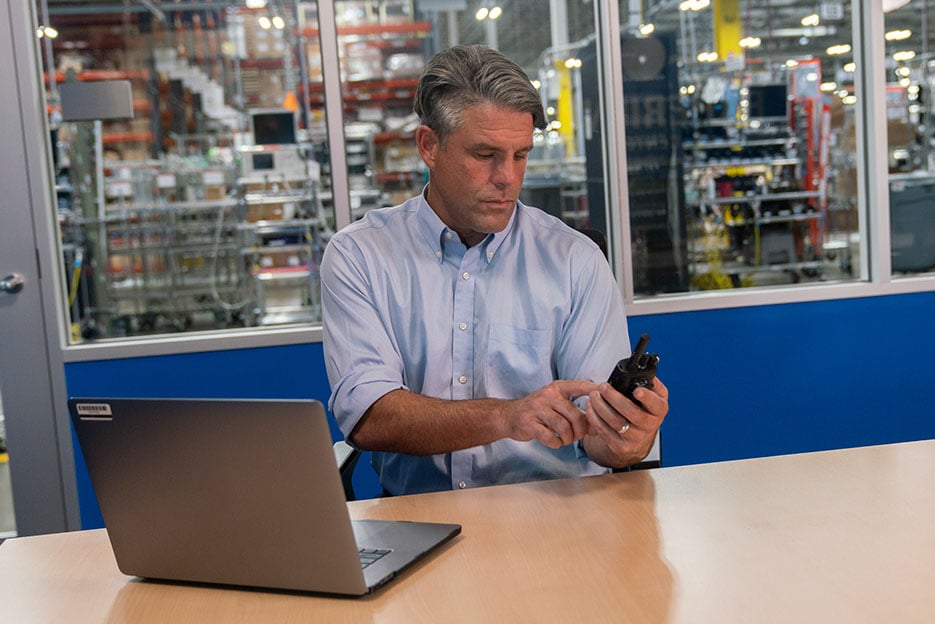 Evolving technology is making it more possible than ever for different devices to communicate with each other so that humans can do what they do best: think and respond.
Evolving technology is making it more possible than ever for different devices to communicate with each other so that humans can do what they do best: think and respond.
It’s called communication interoperability, and it’s allowing for new levels of communication across devices.
How does this work in real life?
Eyes and Ears
Let’s look at what kind of communication happens when a facility — a factory, school, or hospital — experiences some kind of security breach.
When the communications systems are fully integrated by using a platform like Motorola’s Safety Reimagined system, voice, data, analytics, and video are all talking to each other.
Safety Reimagined is a communications ecosystem that is helping schools, hospitals, manufacturing facilities, and public safety organizations unify their communications. The result is better communication with fewer opportunities for human error. It also helps organizations with limited resources put their staff where they need to be, focusing on the core mission.
Smarter Video Surveillance
Personnel can’t be everywhere. But cameras can be. This new generation of video surveillance cameras can capture real‑time and archival footage in critical areas.
Let’s say someone tries to enter a secure area. The Avigilon Network Cameras are able to trigger a workflow, including an alarm that goes out to the two‑way radios.
Both the cameras and two‑way radios are using software called Orchestrate, which does just what its name implies: it connects multiple types of hardware and sends out alerts.
Because it’s cloud‑based, Orchestrate can also send out alerts to computers, tablets, and cellphones.
It improves communication across multiple departments and multiple devices. People look at different devices during the day. So if I’m an officer walking around a school, I might have my radio on me, but I might not have my phone on me, or I'm not at my desk looking at my email.
The point is to get information out to as many people as possible who can then respond as efficiently and as quickly as possible to the incident.
And you avoid that game of “telephone” where people are getting information second and third hand.
In other words, everyone who needs to be in the loop is in the loop.
Conducting Your Business with Orchestrate
Have you ever been frustrated when visiting the doctor when you have to repeat the same information to the phone intake person, the scheduler, the nurse, the doctor, and then a specialist?
Another way of looking at communication interoperability is getting rid of all those steps in between, so people can take action when and where they need to.
These tools keep people safe, and they also have the capacity to increase efficiency and productivity.
Here are a few examples of how communication interoperability can make a difference.
Hospitality Streamlined
For example, hospitality technology has a big impact on the bottom line of businesses that have been struggling since the pandemic.
Communication interoperability means managers, supervisors, receptionists, and front‑line staff can all work together to provide excellent customer service.
For faster room turnovers, someone from the front desk can press a button when a guest checks out, alerting engineering that the room is ready to be cleaned. Engineering sends a work ticket out, assigning the task to a cleaner. They clean the room, and when they’re done, they press a button to let everyone know the room is done and ready for the next visitor.
There are also plenty of situations in the hospitality industry when a quick, coordinated response is needed because a guest’s health or safety is in danger.
Manufacturing Efficiency
Let’s say a piece of equipment breaks on the line. An alarm triggers the software in the conveyor belt, sending an alert that Belt 101 stopped working. An alert goes out immediately to the radio inside the dispatch center, gets pushed to the facilities team and they send a work ticket or a text message (or both). It says the machinery is down, and technicians are able to respond to the incident, fix the conveyor belt, and get it back online. They send a text back to the team saying it’s all completed, and in a matter of minutes, the line is back in operation, saving the company money and hassle.
The same kind of quick response is possible if there’s a security incident, like if a camera detects someone entering a secure area. Cameras work together with the system and the security team to track the intruder until they figure out what’s going on and neutralize any threats to property or people.
Education Safety
The safety of our schools is critically important, and communications interoperability is making it easier for schools to keep students and staff safe.
This technology can help if somebody comes to the front door who shouldn’t be there. The camera can “face match” and detect them, knowing that the person shouldn’t be on campus. The camera sends an alert saying this person is at the front door, and that sends a trigger to security. It alerts the office administrative staff and anybody who should know about the incident. And it might also send it to the local 911 public safety dispatch center, alerting them that somebody's at the school that should not be there, requesting assistance. Or it could just trigger the security people on site to go to the front door and say, ‘You're not allowed on campus. You need to leave. Police are coming to escort you away.’
Sometimes the intelligence of the cameras in recognizing people can save hours and hours of searching through footage to try to identify someone.
Hospital Vigilance
Given that hospitals and health care facilities are supposed to keep people healthy, there are a surprising amount of security and safety incidents. They have people coming in and out their doors all day and night, from different walks of life. People speak languages other than English and need interpretation. In fact, many hospital workers speak other languages, so hospitals need to think about communication and workflows to make sure everyone understands what they need to do.
There are many different access points and doors. So it's good to connect door access with cameras. So, for example, if someone stole a badge, that could be entered into the system right away. That badge would get denied, and the person couldn’t go through any more doors.
The technology could do a lockdown in a specific high‑risk area, like the ER or the mental health ward where sometimes people are hostile or in pain.
The Importance of an Emergency Plan
Communication interoperability tells you what the problem or threat is so you can respond better and faster.
Since a lot of these examples have to do with safety, I’ll repeat something I’ve said before: Technology can’t keep people safer without human involvement. Every organization needs to have an emergency plan.
We need to learn it, practice it with drills, and be ready to respond when something happens.
Public safety organizations are good at this, but a lot of people still think something bad is not going to happen at their school, factory, hospital, or business. We have to be ready for anything.
Of course, communication interoperability looks different for every single business, institution, or entity. Everyone will have a different workflow, and a system for interoperability. It’s so important to talk through your needs, in detail, with someone who knows how to meet your communication challenges.



